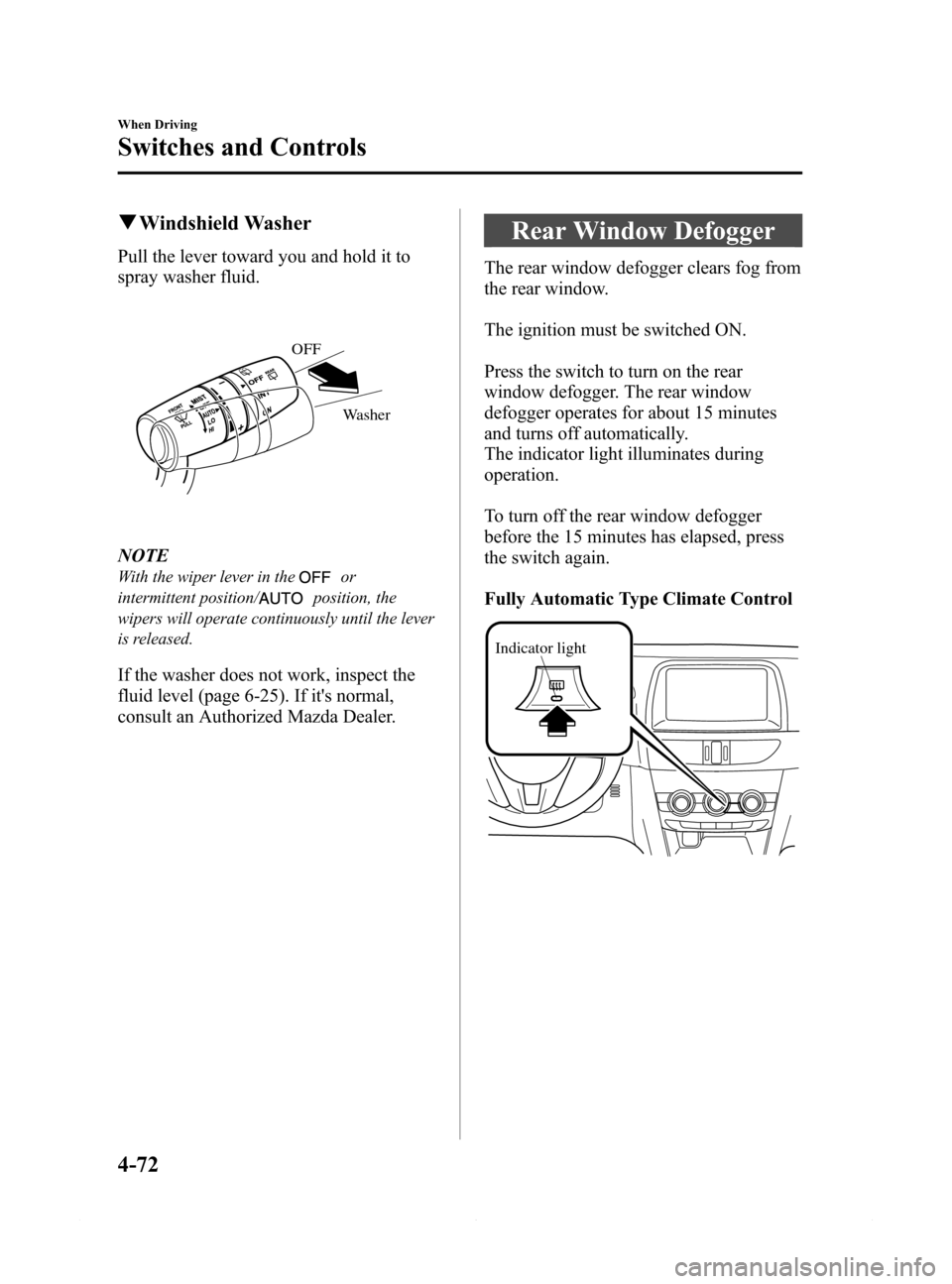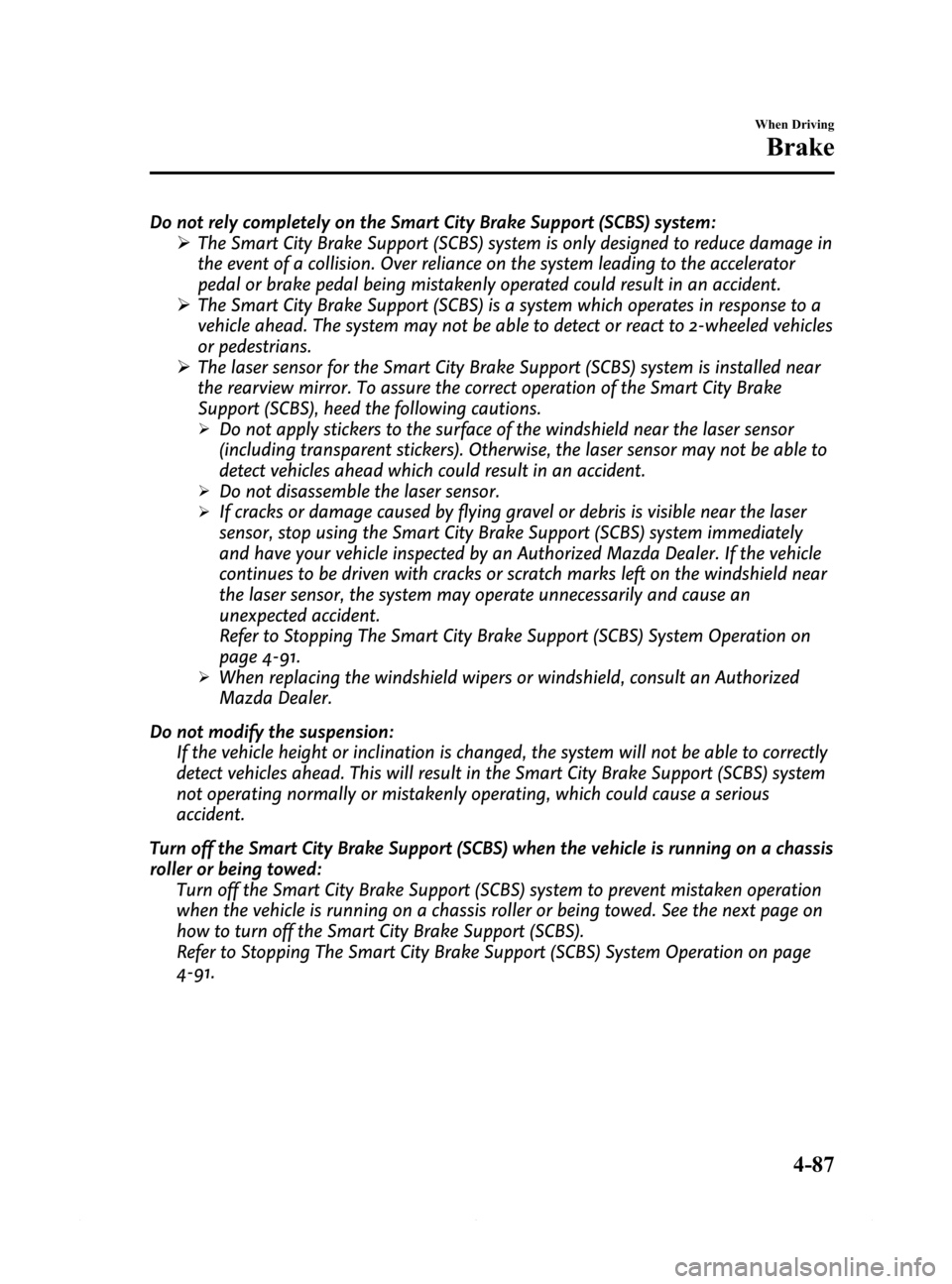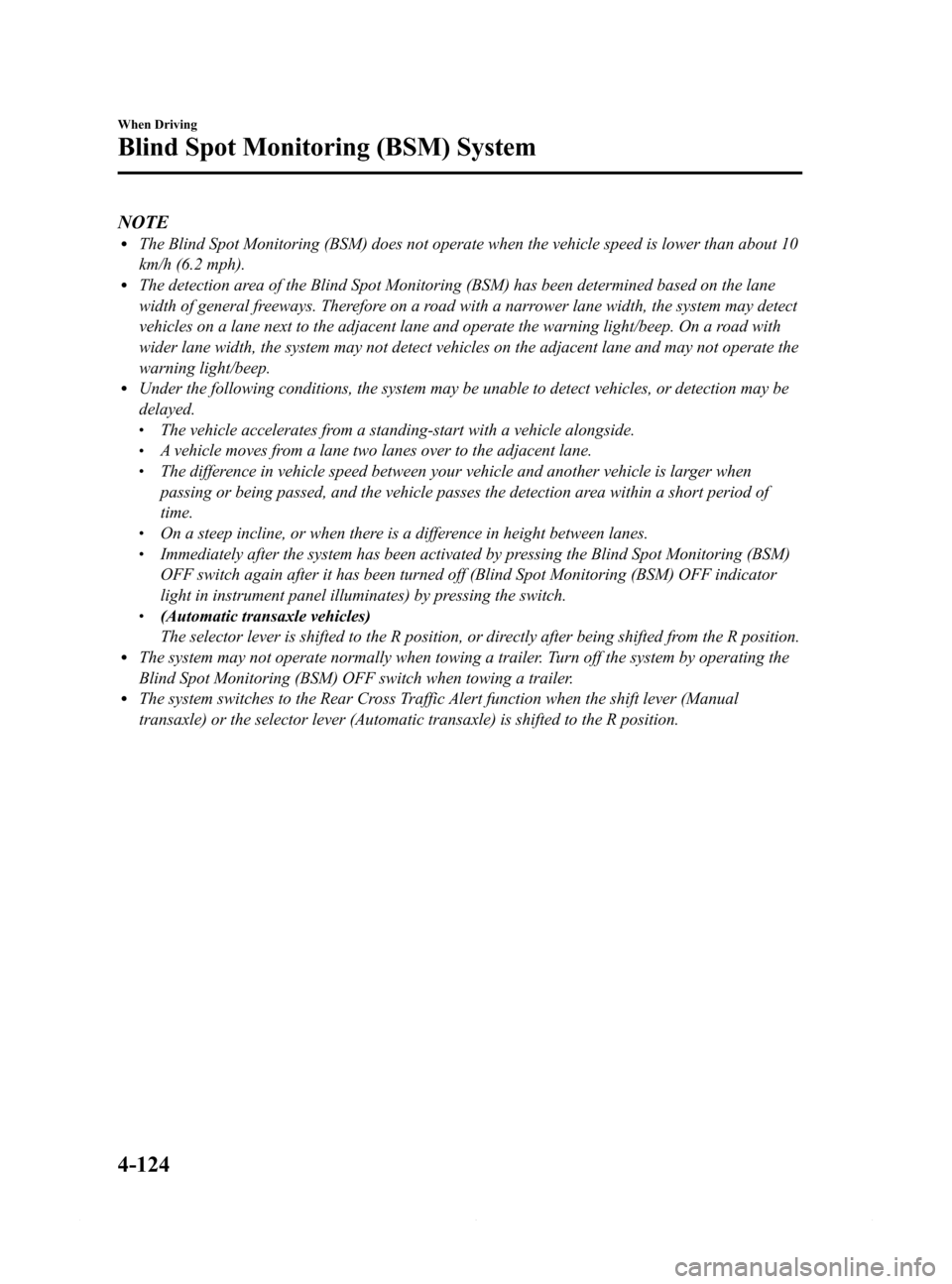tow MAZDA MODEL 6 2014 (in English) User Guide
[x] Cancel search | Manufacturer: MAZDA, Model Year: 2014, Model line: MODEL 6, Model: MAZDA MODEL 6 2014Pages: 576, PDF Size: 8.58 MB
Page 192 of 576

Black plate (192,1)
qLane-Change Signals
Move the lever halfway toward the
direction of the change―until the
indicator flashes―and hold it there. It
will return to the off position when
released.
qThree-Flash Turn Signal
To signal a lane change, operate the turn
signal lever up or down slightly and
release. After releasing the lever, the turn
signal indicator flashes three times.
NOTE
The three-flash turn signal function can be
switched to operable/inoperable using the
personalization function.
Refer to Personalization Features on page 9-9.
Windshield Wipers and
Washer
The ignition must be switched ON.
WARNING
Use only windshield washer fluid or
plain water in the reservoir:
Using radiator antifreeze as washer
fluid is dangerous. If sprayed on the
windshield, it will dirty the
windshield, affect your visibility, and
could result in an accident.
Only use windshield washer fluid
mixed with anti-freeze protection in
freezing weather conditions:
Using windshield washer fluid
without anti-freeze protection in
freezing weather conditions is
dangerous as it could freeze on the
windshield and block your vision
which could cause an accident.
In addition, make sure the
windshield is sufficiently warmed
using the defroster before spraying
the washer fluid.
4-68
When Driving
Switches and Controls
Mazda6_8DQ8-EA-13L_Edition3 Page192
Friday, June 13 2014 6:21 PM
Form No.8DQ8-EA-13L
Page 196 of 576

Black plate (196,1)
qWindshield Washer
Pull the lever toward you and hold it to
spray washer fluid.
Washer OFF
NOTE
With the wiper lever in theor
intermittent position/
position, the
wipers will operate continuously until the lever
is released.
If the washer does not work, inspect the
fluid level (page 6-25). If it's normal,
consult an Authorized Mazda Dealer.
Rear Window Defogger
The rear window defogger clears fog from
the rear window.
The ignition must be switched ON.
Press the switch to turn on the rear
window defogger. The rear window
defogger operates for about 15 minutes
and turns off automatically.
The indicator light illuminates during
operation.
To turn off the rear window defogger
before the 15 minutes has elapsed, press
the switch again.
Fully Automatic Type Climate Control
Indicator light
4-72
When Driving
Switches and Controls
Mazda6_8DQ8-EA-13L_Edition3 Page196
Friday, June 13 2014 6:21 PM
Form No.8DQ8-EA-13L
Page 198 of 576

Black plate (198,1)
Hazard Warning Flasher
The hazard warning lights should always
be used when you stop on or near a
roadway in an emergency.
The hazard warning lights warn other
drivers that your vehicle is a traffic hazard
and that they must take extreme caution
when near it.
Depress the hazard warning flasher and all
the turn signals will flash. The hazard
warning indicator lights in the instrument
cluster flash simultaneously.
NOTE
lThe turn signals do not work when the
hazard warning lights are on.
lCheck local regulations about the use of
hazard warning lights while the vehicle is
being towed to verify that it is not in
violation of the law.
HomeLink Wireless
Control System
í
NOTE
HomeLink and HomeLink house are registered
trademarks of Johnson Controls.
The HomeLink system replaces up to 3
hand-held transmitters with a single built-
in component in the auto-dimming mirror.
Pressing the HomeLink button on the
auto-dimming mirror activates garage
doors, gates and other devices
surrounding your home.
HomeLink button
Indicator light
4-74
When Driving
íSome models.
Switches and Controls
Mazda6_8DQ8-EA-13L_Edition3 Page198
Friday, June 13 2014 6:21 PM
Form No.8DQ8-EA-13L
Page 208 of 576

Black plate (208,1)
Hill Launch Assist (HLA)
Hill Launch Assist (HLA) is a function
which assists the driver in accelerating
from a stop while on a slope. When the
driver releases the brake pedal and
depresses the accelerator pedal while on a
slope, the function prevents the vehicle
from rolling.
The braking force is maintained
automatically after the brake pedal is
released on a steep grade.
For vehicles with a manual transaxle, Hill
Launch Assist (HLA) operates on a
downward slope when the shift lever is in
the reverse (R) position, and on an
upward slope when the shift lever is in a
position other than the reverse (R)
position.
For vehicles with an automatic transaxle,
Hill Launch Assist (HLA) operates on a
downward slope when the shift lever is in
the reverse (R) position, and on an
upward slope when the shift lever is in a
forward gear.
WARNING
Do not rely completely on Hill Launch
Assist (HLA):
Hill Launch Assist (HLA) is an
auxiliary device for accelerating from
a stop on a slope. The system only
operates for about two seconds and
therefore, relying only on the system,
when accelerating from a stop is
dangerous because the vehicle may
move (roll) unexpectedly and cause
an accident.
The vehicle could roll depending on
the vehicle's load or if it is towing
something. In addition, for vehicles
with a manual transaxle, the vehicle
could still roll depending on how the
clutch pedal or the accelerator pedal
is operated.
Always confirm the safety around the
vehicle before starting to drive the
vehicle.
4-84
When Driving
Brake
Mazda6_8DQ8-EA-13L_Edition3 Page208
Friday, June 13 2014 6:21 PM
Form No.8DQ8-EA-13L
Page 211 of 576

Black plate (211,1)
Do not rely completely on the Smart City Brake Support (SCBS) system:
ØThe Smart City Brake Support (SCBS) system is only designed to reduce damage in
the event of a collision. Over reliance on the system leading to the accelerator
pedal or brake pedal being mistakenly operated could result in an accident.
ØThe Smart City Brake Support (SCBS) is a system which operates in response to a
vehicle ahead. The system may not be able to detect or react to 2-wheeled vehicles
or pedestrians.
ØThe laser sensor for the Smart City Brake Support (SCBS) system is installed near
the rearview mirror. To assure the correct operation of the Smart City Brake
Support (SCBS), heed the following cautions.
ØDo not apply stickers to the surface of the windshield near the laser sensor
(including transparent stickers). Otherwise, the laser sensor may not be able to
detect vehicles ahead which could result in an accident.
ØDo not disassemble the laser sensor.
ØIf cracks or damage caused by flying gravel or debris is visible near the laser
sensor, stop using the Smart City Brake Support (SCBS) system immediately
and have your vehicle inspected by an Authorized Mazda Dealer. If the vehicle
continues to be driven with cracks or scratch marks left on the windshield near
the laser sensor, the system may operate unnecessarily and cause an
unexpected accident.
Refer to Stopping The Smart City Brake Support (SCBS) System Operation on
page 4-91.
ØWhen replacing the windshield wipers or windshield, consult an Authorized
Mazda Dealer.
Do not modify the suspension:
If the vehicle height or inclination is changed, the system will not be able to correctly
detect vehicles ahead. This will result in the Smart City Brake Support (SCBS) system
not operating normally or mistakenly operating, which could cause a serious
accident.
Turn off the Smart City Brake Support (SCBS) when the vehicle is running on a chassis
roller or being towed:
Turn off the Smart City Brake Support (SCBS) system to prevent mistaken operation
when the vehicle is running on a chassis roller or being towed. See the next page on
how to turn off the Smart City Brake Support (SCBS).
Refer to Stopping The Smart City Brake Support (SCBS) System Operation on page
4-91.
When Driving
Brake
4-87
Mazda6_8DQ8-EA-13L_Edition3 Page211
Friday, June 13 2014 6:21 PM
Form No.8DQ8-EA-13L
Page 213 of 576

Black plate (213,1)
NOTElThe Smart City Brake Support (SCBS) system will not operate if the driver is deliberately
performing driving operations (accelerator pedal and steering wheel).
lThe Smart City Brake Support (SCBS) system will operate under the following conditions.lThe engine is running.lThe display in the instrument cluster does not indicate that the system requires inspection or it
cannot be used.
lThe vehicle speed is between about 4 to 30 km/h (2 to 18 mph).lThe Smart City Brake Support (SCBS) system is not turned off.lThe DSC operation is not turned off using the DSC OFF switch.lThe DSC is not malfunctioning.lThe Smart City Brake Support (SCBS) detects a vehicle ahead by emitting a near-infrared laser
beam and receiving the beam reflected off the reflector of the vehicle ahead, and then using it for
the measurement. Consequently, the Smart City Brake Support (SCBS) may not operate under the
following conditions:
lReflection of the laser is poor due to the shape of the vehicle ahead.lThe vehicle ahead is significantly dirty.lUnder bad weather condition, such as rain, fog and snow.lThe window washer is being used or the windshield wipers are not used when it's raining.lThe windshield is dirty.lThe steering wheel is turned completely left or right, or the vehicle is accelerated rapidly and
comes close to the vehicle ahead.
lTrucks with low loading platforms and vehicles with an extremely low or high profile.lVehicles with certain shapes such as a vehicle carrier.lUnder the following conditions, the Smart City Brake Support (SCBS) system may not operate
normally.
lHeavy luggage is loaded in the luggage compartment or on the rear seat.lIf there is the possibility of partial contact with a vehicle ahead.lWhen driving on continuously curving roads, and entering and exiting exits.lElongated luggage or cargo is loaded onto installed roof rails and covers the laser sensor.lExhaust gas from the vehicle in front, sand, snow, and water vapor rising from manholes and
grating, and water splashed into the air.
lWhen towing a malfunctioning vehicle.lIn the following cases, the laser sensor may inadvertently determine that there is a vehicle ahead
and the Smart City Brake Support (SCBS) system may operate.
lObjects on the road at the entrance to a curve.lVehicles passing in the opposite lane while making a curve.lMetal objects, bumps, or protruding objects on the road.lWhen passing through a toll gate.lWhen passing under a vinyl curtain or flag.lPlastic objects such as pylons.lTwo-wheeled vehicles, pedestrians, animals or standing trees.lVehicle is driven with some of the tires having significant wear.
When Driving
Brake
4-89
Mazda6_8DQ8-EA-13L_Edition3 Page213
Friday, June 13 2014 6:21 PM
Form No.8DQ8-EA-13L
Page 227 of 576

Black plate (227,1)
WARNING
Do not rely completely on the Mazda Radar Cruise Control (MRCC) system and
always drive carefully:
The Mazda Radar Cruise Control (MRCC) system is designed to reduce load on the
driver, and although it maintains a constant vehicle speed, or specifically, it
maintains a constant distance between your vehicle and the detected vehicle ahead
according to the vehicle speed, the system has detection limitations depending on the
type of vehicle ahead and its conditions, the weather conditions, and the road
conditions. Additionally, the system may be unable to decelerate sufficiently to avoid
hitting the vehicle ahead if the vehicle ahead applies the brakes suddenly or another
vehicle cuts into the driving lane, which could result in an accident. Always verify the
safety of the surrounding area and depress the brake pedal or accelerator pedal
while keeping a safe distance from vehicles ahead or on-coming vehicles.
Do not use the Mazda Radar Cruise Control (MRCC) system in the following locations.
Otherwise, it could lead to an accident:
ØRoads with sharp curves and where vehicle traffic is heavy and there is insufficient
space between vehicles. Roads where frequent and repetitive acceleration and
deceleration occur (Driving under these conditions using the Mazda Radar Cruise
Control (MRCC) system is not possible).
ØWhen entering and exiting interchanges, service areas, and parking areas of
highways (If you exit a highway while headway control is in use, the vehicle
ahead will no longer be tracked and your vehicle may accelerate to the set speed).
ØSlippery roads such as ice or snow-bound roads (The tires could spin causing you
to lose vehicle control).
ØLong descending slopes (to maintain distance between vehicles, the system
automatically and continuously applies the brakes which could result in the loss
of brake power).
For the purposes of safety, switch the Mazda Radar Cruise Control (MRCC) system off
when it is not being used.
CAUTION
If the vehicle is towed or you are towing something, switch the Mazda Radar Cruise
Control (MRCC) system off to prevent a miss-operation.
When Driving
Mazda Radar Cruise Control (MRCC)
4-103
Mazda6_8DQ8-EA-13L_Edition3 Page227
Friday, June 13 2014 6:21 PM
Form No.8DQ8-EA-13L
Page 248 of 576

Black plate (248,1)
NOTElThe Blind Spot Monitoring (BSM) does not operate when the vehicle speed is lower than about 10
km/h (6.2 mph).
lThe detection area of the Blind Spot Monitoring (BSM) has been determined based on the lane
width of general freeways. Therefore on a road with a narrower lane width, the system may detect
vehicles on a lane next to the adjacent lane and operate the warning light/beep. On a road with
wider lane width, the system may not detect vehicles on the adjacent lane and may not operate the
warning light/beep.
lUnder the following conditions, the system may be unable to detect vehicles, or detection may be
delayed.
lThe vehicle accelerates from a standing-start with a vehicle alongside.lA vehicle moves from a lane two lanes over to the adjacent lane.lThe difference in vehicle speed between your vehicle and another vehicle is larger when
passing or being passed, and the vehicle passes the detection area within a short period of
time.
lOn a steep incline, or when there is a difference in height between lanes.lImmediately after the system has been activated by pressing the Blind Spot Monitoring (BSM)
OFF switch again after it has been turned off (Blind Spot Monitoring (BSM) OFF indicator
light in instrument panel illuminates) by pressing the switch.
l(Automatic transaxle vehicles)
The selector lever is shifted to the R position, or directly after being shifted from the R position.
lThe system may not operate normally when towing a trailer. Turn off the system by operating the
Blind Spot Monitoring (BSM) OFF switch when towing a trailer.
lThe system switches to the Rear Cross Traffic Alert function when the shift lever (Manual
transaxle) or the selector lever (Automatic transaxle) is shifted to the R position.
4-124
When Driving
Blind Spot Monitoring (BSM) System
Mazda6_8DQ8-EA-13L_Edition3 Page248
Friday, June 13 2014 6:21 PM
Form No.8DQ8-EA-13L
Page 253 of 576

Black plate (253,1)
qBSM OFF Switch
When the BSM OFF switch is pressed,
the BSM system turns off and the BSM
OFF indicator light illuminates.
Press the BSM OFF switch again to turn
on the BSM system. The BSM OFF
indicator light turns off.
NOTE
lThe system may not operate normally when
towing a trailer. Turn off the system by
operating the BSM OFF switch when
towing a trailer.
lIf the ignition is switched off with the BSM
system turned off, the system becomes
operable automatically when the ignition is
switched ON.
qCare of Radar Sensors
The radar sensors are equipped inside the
rear bumper.
Radar sensors
Always keep the bumper surface near the
radar sensor area clean so that the BSM
system operates normally. Refer to
Exterior Care on page 6-58.
NOTE
lThe BSM OFF indicator light flashes if the
radar sensors cannot operate normally. If
the light remains flashing after cleaning the
bumper surface near the radar sensor area,
consult an Authorized Mazda Dealer.
lFor repairs or paintwork around the radar
sensors, or replacement of the bumper,
consult an Authorized Mazda Dealer.
When Driving
Blind Spot Monitoring (BSM) System
4-129
Mazda6_8DQ8-EA-13L_Edition3 Page253
Friday, June 13 2014 6:21 PM
Form No.8DQ8-EA-13L
Page 287 of 576

Black plate (287,1)
Multipath noise
Since FM signals can be reflected by
obstructions, it is possible to receive both
the direct signal and the reflected signal at
the same time. This causes a slight delay
in reception and may be heard as a broken
sound or a distortion. This problem may
also be encountered when in close
proximity to the transmitter.
Reflected wave
Direct
Flutter/Skip noise
Signals from an FM transmitter move in
straight lines and become weak in valleys
between tall buildings, mountains, and
other obstacles. When a vehicle passes
through such an area, the reception
conditions may change suddenly, resulting
in annoying noise.
Weak signal noise
In suburban areas, broadcast signals
become weak because of distance from
the transmitter. Reception in such fringe
areas is characterized by sound breakup.
Strong signal noise
This occurs very close to a transmitter
tower. The broadcast signals are
extremely strong, so the result is noise and
sound breakup at the radio receiver.
Station drift noise
When a vehicle reaches the area of two
strong stations broadcasting at similar
frequencies, the original station may be
temporarily lost and the second station
picked up. At this time there will be some
noise from this disturbance.
Station 2
88.3 MHz Station 1
88.1 MHz
Interior Features
Audio System
5-15
Mazda6_8DQ8-EA-13L_Edition3 Page287
Friday, June 13 2014 6:22 PM
Form No.8DQ8-EA-13L